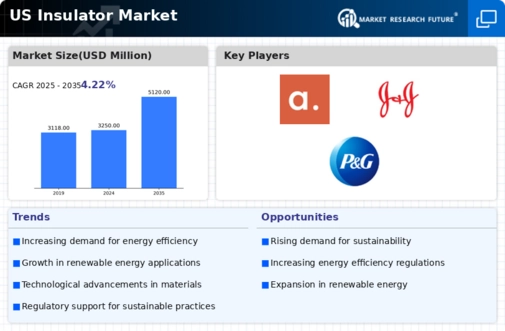Rising Demand for Renewable Energy
The insulator market is experiencing a notable surge in demand driven by the increasing adoption of renewable energy sources such as wind and solar power. As the U.S. government emphasizes the transition to cleaner energy, the need for reliable insulators in power transmission systems becomes critical. In 2025, the renewable energy sector is projected to account for approximately 30% of the total energy generation in the U.S., necessitating robust insulator solutions to ensure efficient energy transfer. This shift not only enhances the resilience of the electrical grid but also propels the insulator market forward, as manufacturers innovate to meet the specific requirements of renewable energy applications.
Urbanization and Population Growth
Urbanization and population growth in the U.S. are contributing to the expansion of the insulator market. As cities grow and populations increase, the demand for reliable electrical infrastructure intensifies. The U.S. Census Bureau projects that urban areas will house approximately 85% of the population by 2030, necessitating upgrades to existing power distribution systems. This urban expansion requires the installation of new power lines and substations, which in turn drives the need for high-performance insulators. Consequently, manufacturers are likely to focus on developing innovative insulator solutions that cater to the unique challenges posed by urban environments, thereby enhancing the overall market landscape.
Investment in Smart Grid Technologies
The insulator market is poised for growth due to the increasing investment in smart grid technologies across the U.S. Smart grids enhance the efficiency and reliability of electricity distribution, necessitating advanced insulator solutions that can withstand the demands of modern electrical systems. As utility companies allocate substantial budgets towards upgrading infrastructure, the insulator market stands to benefit significantly. In 2025, it is estimated that investments in smart grid technologies will exceed $100 billion, creating a robust demand for high-quality insulators that support these advanced systems. This trend suggests a promising future for manufacturers who can provide innovative insulator products tailored to smart grid applications.
Regulatory Compliance and Safety Standards
The insulator market is significantly influenced by stringent regulatory compliance and safety standards imposed by federal and state authorities. These regulations are designed to ensure the reliability and safety of electrical infrastructure, particularly in high-voltage applications. As of 2025, compliance with the National Electrical Safety Code (NESC) is mandatory for utility companies, which drives the demand for high-quality insulators that meet these standards. The emphasis on safety and reliability in electrical installations compels manufacturers to invest in advanced materials and technologies, thereby fostering growth in the insulator market. This trend indicates a robust market environment where adherence to regulations is paramount.
Technological Innovations in Material Science
Technological innovations in material science are reshaping the insulator market by introducing advanced materials that enhance performance and durability. The development of composite insulators, which combine various materials to improve electrical and mechanical properties, is particularly noteworthy. These innovations not only extend the lifespan of insulators but also reduce maintenance costs for utility companies. As of 2025, the market for composite insulators is expected to grow by approximately 15% annually, reflecting the industry's shift towards more efficient and sustainable solutions. This trend indicates that manufacturers are increasingly investing in research and development to create insulators that meet the evolving demands of the electrical grid.

















Leave a Comment